RELATED CONTENT

By Delia Paunescu: Assistant Editor
NEW YORK—Modern technology and the current economic climate have
created new expectations from consumers and thus, new requirements for
retailers.
The world of eyewear dispensing now includes many more community
and cultural involvements. An ever-increasing number of retailers and
ECPs are partnering with the art community both because of the cultural
ties the collaboration brings to their business and the wide
marketability of such events.
In an age when consumers are looking for enhanced meaning in
their purchases, retailers host gallery-style shows within their stores
to bring attention to the artwork as well as to their product. Actual
works of art—whether traditional paintings, photographs, sculptures and
even non-traditional forms such as puppetry and performance art—are
created as a means of expressing an alternate point of view. Alongside
the artwork, customers look at the eyewear collections inside the
display cases with a fresh perspective. By creating art collaborations,
boutiques are bringing a new dimension to their brand and reaching out
to new constituents, VM has learned.
From creation and design to selection and fitting, it is easy to
see why the connection is often made that eyewear itself is an art form.
“The great thing about eyeglasses is that they are a piece of art
already,” said Sophie Raubiet, vice president of U.S. retail for Alain
Mikli, which has been incorporating art from neighboring Madison Avenue
galleries into the designer’s New York boutiques.
“We’ve always wanted to emphasize a very large and expansive
concept of vision that is beyond the frame. And artists teach us to look
at the world differently,” explained Brent Zerger, director of
communications and retail operations for l.a.Eyeworks. The California
brand has been entwined with the art community since their first store
opened on Melrose Ave. in 1979. “That’s part of the journey that we want
to take our clients on,” he said.
“By showcasing art, you also have the opportunity to showcase the
more artful frames,” explained Brad Bodkin, OD, owner of The Vision
Center at Seaside Farms in Mount Pleasant, S.C. His single-location
practice recently incorporated paintings and jewelry from local artists
as part of their one-year anniversary celebration. Bodkin related that
the positive response from customers inspired him to consider more art
shows.
Vision Monday spoke to retailers and ECPs throughout the country
who have incorporated artistic projects and special events into their
businesses. Among those, some have long-established art series, so
popular that they describe the eyewear as competing for attention with
the works of art which draw customers into the shop. Others are just
starting out, feeling their way around the unfamiliar world of in-store
art installation.
Regardless of the history behind various art affiliations, it’s
becoming clear that optical retailers throughout the country are opening
their shop doors for more than just eyeglasses. Following are a few
examples of how some ECPs have incorporated art into their business.
CHICAGO—Early in 2008, Spex, a 14-unit retailer based here, began
its “Art+Vision” series, which has evolved from a small cocktail party
into what Spex describes as “a platform for local artists to show their
work in a retail environment with diverse public exposure.”

|
|
MARILYN FRANK
|
|
Marketing director Marilyn Frank said the idea originated at
Spex’s Highland Park location when that store’s manager requested to
change the 10-year-old artwork in the space. “I thought, ‘What if we had
a local artist come in, put up their stuff and throw a party?’” In the
past two years, Frank said a total of 30 Art+Vision partnerships have
taken place at Spex’s 14 Chicago-area locations. The show has evolved to
include trunk show pairings.
For their program, Spex allows the invited artists—who have
included Kate Friedman, Angie Garbot and Tom Blandford—to determine how
their art should be featured in the store. Once arranged, a
gallery-style opening night is planned and guests are invited via
in-store flier and e-mail alert. The reception often involves
cross-marketing with local restaurants. According to Frank, the art
remains on display for four to six weeks during which time customers can
purchase it.
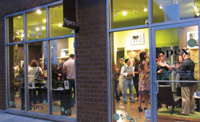
|
|
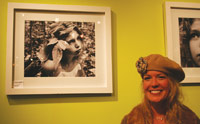
|
|
| Spex’s West Loop location during an Art+Vision event (top) and artist Jill Dunbar at her Spex showcase (bottom). |
|
However, Frank insisted that Spex is not involved in selling the
art. “We refer the purchaser to the artist,” she said, adding that
artists are encouraged to leave promotional material which Spex staff
distributes to interested parties.
Frank admitted her original expectation was to increase business.
“You can’t do something like this and have people respond in a negative
way. I don’t think that anybody could walk in and scoff that we’re
supporting local art. It’s a good thing,” she said. However, she added
that the series has gone far past that in increasing awareness of the
Spex brand, bringing in new customers and generating loyalty. “I didn’t
realize that things would snowball by word-of-mouth or that people would
be so enthusiastic. That was a nice surprise,” she said.
“Spex is civically minded, culturally aware and conscious of the
importance of creativity. We understand the necessity of extending
creative pursuits in our communities,” she said. As an artist herself,
Frank said it’s important to let Spex clients know that the company is
in touch with their customers beyond the “run-of-mill optical sale.”
Spex recently partnered with the Chicago Loop Alliance for their
largest art collaboration (both in size and exposure) to bring the
public art project, “Eye” from visual artist Tony Tasset (a past
Art+Vision participant), in the city’s Pritzker Park. The collaboration
was promoted through social networking sites such as Facebook and
Twitter and was featured on local television stations. Frank said Spex
will continue their involvement in community art with Pop-Up Art Loop, a
project which finds empty businesses in downtown Chicago and uses their
space to house the work of local artists.
0
COLUMBUS, S.C.—When Mark Plessinger opened his optical boutique
Frame of Mind, The Art of Eyewear (FOM) here three years ago, his goal
was to impact people’s lives through eyewear. “This isn’t about putting
glasses on the masses, but about affecting people on a much smaller
level that makes them feel better when they walk out the door,” he said.
|
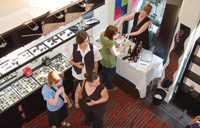
|
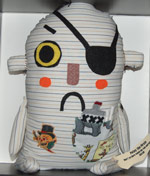
|
|
Local wine shop Cellar on Green sponsored the March 4 event and Jenny Mae Hill’s “sock oddities” on display (right). |
|
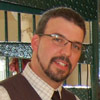
|
|
MARK PLESSINGER
|
|
After six months of “figuring out how to get the name out and
people in the door,” Plessinger, an optician, decided to use the store’s
loft space upstairs to showcase art. He tapped into Columbus’ art
community for the first show and has done so ever since.
Today, the monthly FOM series spills out of his 1,000 square foot
location and onto the sidewalks of Main Street, Columbus, where, over
the years, Plessinger has convinced neighboring businesses to host their
own art events on the first Thursday of every month.
“I’m putting on events that maybe cost me $200 and I’m getting a
minimum of 50 people in the door who never knew I existed,” Plessinger
said.
As for the series he created, Plessinger said: “It has defined
who we are and what we are. It’s given us way more brand recognition
than we ever could have imagined. Now when you say ‘FOM’ people think of
art. The series has brought us to the forefront of people’s mind.”
0
MOUNT PLEASANT, S.C.—The Vision Center at Seaside Farms first
incorporated art into its location as part of the practices’ one-year
anniversary. Brad Bodkin, OD, Vision Center’s owner and president,
invited artist Laura Martindale to display her paintings during the
day-long celebration. The event was advertised on the practice’s website
and Facebook page.

|
|
BRAD BODKIN
|
|
|
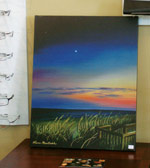
|
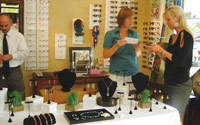
|
|
|
Painting by Laura Martindale (left) and the celebration which included local jewelry artist Jaycie Rappold (right).
|
“By showcasing art, you also have the opportunity to showcase the
more artful frames,” Bodkin said. “We’re definitely seeing a trend in
people being more artistic with the frames—more colors, more
characteristics.”
Bodkin said having the artwork enhanced the office and generally
made the walls look better, giving the public another reason to come in.
According to him, Vision Center is in the process of starting a more
regular art series.
“We want to drive a new customer base to the office. If word gets
out and [the events] become a success, hopefully we can also show our
office secondary to the art and it’ll bring these art visitors in as
customers later,” he said. “We want people to think of us as a
culturally relevant place that showcases beautiful things as opposed to
somewhere they just get their glasses.”
■
■